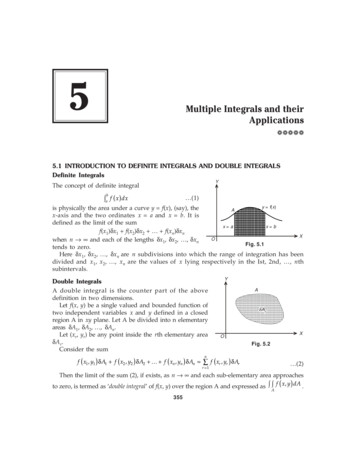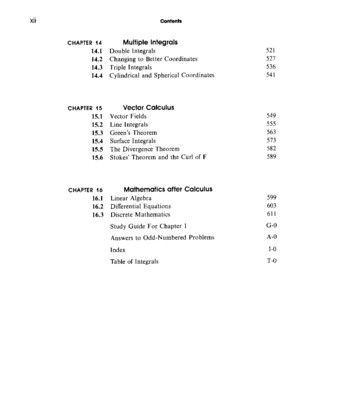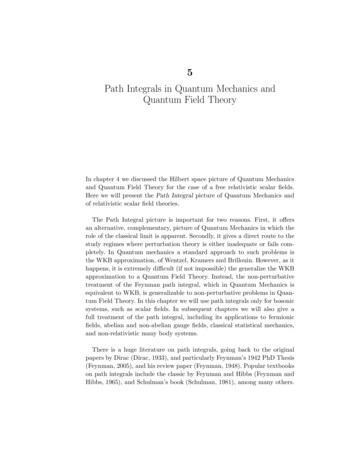
Transcription
Chapter 15Multiple IntegralsStewart, Calculus: Early Transcendentals, 8th Edition. 2016 Cengage. All Rights Reserved. May not bescanned, copied or duplicated, or posted to a publicly accessible website, in whole or in part.
15.9 Change of Variables in Multiple IntegralsStewart, Calculus: Early Transcendentals, 8th Edition. 2016 Cengage. All Rights Reserved. May not bescanned, copied or duplicated, or posted to a publicly accessible website, in whole or in part.
Change of Variables in Multiple Integrals (1 of 19)In one-dimensional calculus we often use a change of variable (a substitution)to simplify an integral. By reversing the roles of x and u, we can write1 a f ( x ) dx c f ( g (u ) ) g (u ) dubdwhere x g(u) and a g(c), b g(d). Another way of writing Formula 1 is asfollows:2b af ( x ) dx f ( x (u ) )dcdxduduStewart, Calculus: Early Transcendentals, 8th Edition. 2016 Cengage. All Rights Reserved. May not bescanned, copied or duplicated, or posted to a publicly accessible website, in whole or in part.
Change of Variables in Multiple Integrals (2 of 19)A change of variables can also be useful in double integrals. We have alreadyseen one example of this: conversion to polar coordinates. The new variables rand θ are related to the old variables x and y by the equationsx r cos y r sin and the change of variables formula can be written as R f ( x, y ) dA S f ( r cos , r sin ) rdr d where S is the region in the rθ-plane that corresponds to the region R in the xyplane.Stewart, Calculus: Early Transcendentals, 8th Edition. 2016 Cengage. All Rights Reserved. May not bescanned, copied or duplicated, or posted to a publicly accessible website, in whole or in part.
Change of Variables in Multiple Integrals (3 of 19)More generally, we consider a change of variables that is given by atransformation T from the uv-plane to the xy-plane:T(u, v) (x, y)where x and y are related to u and v by the equationsx g ( u, v )3y h (u, v )or, as we sometimes write,x x ( u, v )y y (u, v )Stewart, Calculus: Early Transcendentals, 8th Edition. 2016 Cengage. All Rights Reserved. May not bescanned, copied or duplicated, or posted to a publicly accessible website, in whole or in part.
Change of Variables in Multiple Integrals (4 of 19)We usually assume that T is a C 1 transformation, which means that g and hhave continuous first-order partial derivatives.A transformation T is really just a function whose domain and range are bothsubsets of 2 .If T(u1, v1) (x1, y1), then the point (x1, y1) is called the image of the point (u1, v1).If no two points have the same image, T is called one-to-one.Stewart, Calculus: Early Transcendentals, 8th Edition. 2016 Cengage. All Rights Reserved. May not bescanned, copied or duplicated, or posted to a publicly accessible website, in whole or in part.
Change of Variables in Multiple Integrals (5 of 19)Figure 1 shows the effect of a transformation T on a region S in the uv-plane.T transforms S into a region R in the xy-plane called the image of S, consistingof the images of all points in S.Figure 1Stewart, Calculus: Early Transcendentals, 8th Edition. 2016 Cengage. All Rights Reserved. May not bescanned, copied or duplicated, or posted to a publicly accessible website, in whole or in part.
Change of Variables in Multiple Integrals (6 of 19)If T is a one-to-one transformation, then it has an inverse transformation T 1from the xy-plane to the uv-plane and it may be possible to solve Equations 3for u and v in terms of x and y:u G ( x, y )v H ( x, y )Stewart, Calculus: Early Transcendentals, 8th Edition. 2016 Cengage. All Rights Reserved. May not bescanned, copied or duplicated, or posted to a publicly accessible website, in whole or in part.
Example 1A transformation is defined by the equationsx u2 v 2y 2uvFind the image of the squareS ( u, v ) 0 u 1, 0 v 1 .Solution:The transformation maps the boundary of S into the boundary of the image.So we begin by finding the images of the sides of S.Stewart, Calculus: Early Transcendentals, 8th Edition. 2016 Cengage. All Rights Reserved. May not bescanned, copied or duplicated, or posted to a publicly accessible website, in whole or in part.
Example 1 – Solution (1 of 4)The first side, S1, is given by v 0 (0 u 1). (See Figure 2.)Figure 2Stewart, Calculus: Early Transcendentals, 8th Edition. 2016 Cengage. All Rights Reserved. May not bescanned, copied or duplicated, or posted to a publicly accessible website, in whole or in part.
Example 1 – Solution (2 of 4)From the given equations we have x u 2 , y 0, and so 0 x 1.Thus S1 is mapped into the line segment from (0, 0) to (1, 0) in the xy-plane.The second side, S2, is u 1 (0 v 1) and, putting u 1 in the givenequations, we getx 1 v 2y 2vStewart, Calculus: Early Transcendentals, 8th Edition. 2016 Cengage. All Rights Reserved. May not bescanned, copied or duplicated, or posted to a publicly accessible website, in whole or in part.
Example 1 – Solution (3 of 4)Eliminating v, we obtain4y2x 1 40 x 1which is part of a parabola.Similarly, S3 is given by v 1 (0 u 1), whose image is the parabolic arc5y2x 14 1 x 0Stewart, Calculus: Early Transcendentals, 8th Edition. 2016 Cengage. All Rights Reserved. May not bescanned, copied or duplicated, or posted to a publicly accessible website, in whole or in part.
Example 1 – Solution (4 of 4)Finally, S4 is given by u 0 (0 v 1) whose image is x v 2 , y 0, that is,–1 x 0. (Notice that as we move around the square in the counterclockwisedirection, we also move around the parabolic region in the counterclockwisedirection.)The image of S is the region R (shown in Figure 2)bounded by the x-axis and the parabolas given byEquations 4 and 5.Figure 2Stewart, Calculus: Early Transcendentals, 8th Edition. 2016 Cengage. All Rights Reserved. May not bescanned, copied or duplicated, or posted to a publicly accessible website, in whole or in part.
Change of Variables in Multiple Integrals (7 of 19)Now let’s see how a change of variables affects a double integral. We start witha small rectangle S in the uv-plane whose lower left corner is the point (u0, v0)and whose dimensions are Δu and Δv. (See Figure 3.)Figure 3Stewart, Calculus: Early Transcendentals, 8th Edition. 2016 Cengage. All Rights Reserved. May not bescanned, copied or duplicated, or posted to a publicly accessible website, in whole or in part.
Change of Variables in Multiple Integrals (8 of 19)The image of S is a region R in the xy-plane, one of whose boundary points is(x0, y0) T(u0, v0).The vectorr(u, v) g(u, v) i h(u, v) jis the position vector of the image of the point (u, v).The equation of the lower side of S is v v0, whose image curve is given by thevector function r(u, v0).Stewart, Calculus: Early Transcendentals, 8th Edition. 2016 Cengage. All Rights Reserved. May not bescanned, copied or duplicated, or posted to a publicly accessible website, in whole or in part.
Change of Variables in Multiple Integrals (9 of 19)The tangent vector at (x0, y0) to this image curve isru gu ( u0 , v 0 ) i hu ( u0 , v 0 ) j x yi j u uSimilarly, the tangent vector at (x0, y0) to the image curve of the left side of S(namely, u u0) isrv gv ( u0 , v 0 ) i hv ( u0 , v 0 ) j x yi j v vStewart, Calculus: Early Transcendentals, 8th Edition. 2016 Cengage. All Rights Reserved. May not bescanned, copied or duplicated, or posted to a publicly accessible website, in whole or in part.
Change of Variables in Multiple Integrals (10 of 19)We can approximate the image region R T(S) by a parallelogram determinedby the secant vectorsa r ( u0 u, v 0 ) r ( u0 , v 0 ) b r (u0 , v 0 v ) r (u0 , v 0 )shown in Figure 4.Figure 4Stewart, Calculus: Early Transcendentals, 8th Edition. 2016 Cengage. All Rights Reserved. May not bescanned, copied or duplicated, or posted to a publicly accessible website, in whole or in part.
Change of Variables in Multiple Integrals (11 of 19)Butru limr ( u0 u, v 0 ) r ( u0 , v 0 ) u u 0and sor(u0 Δu, v0) – r(u0, v0) Δu ruSimilarlyr(u0, v0 Δv) – r(u0, v0) Δv rvThis means that we can approximate R by a parallelogram determined by thevectors Δu ru and Δv rv. (See Figure 5.)Figure 5Stewart, Calculus: Early Transcendentals, 8th Edition. 2016 Cengage. All Rights Reserved. May not bescanned, copied or duplicated, or posted to a publicly accessible website, in whole or in part.
Change of Variables in Multiple Integrals (12 of 19)Therefore we can approximate the area of R by the area of this parallelogram,which is6( u ru ) ( v rv ) ru rv u vComputing the cross product, we obtainru rv ijk x u y u0 x v y v0 x u y u x v y vk x u x v y u y vkStewart, Calculus: Early Transcendentals, 8th Edition. 2016 Cengage. All Rights Reserved. May not bescanned, copied or duplicated, or posted to a publicly accessible website, in whole or in part.
Change of Variables in Multiple Integrals (13 of 19)The determinant that arises in this calculation is called the Jacobian of thetransformation and is given a special notation.7 Definition The Jacobian of the transformation T given by x g(u, v) and y h(u, v) is ( x, y ) ( u, v ) x u y u x v x y x y y u v v u vWith this notation we can use Equation 6 to give an approximation to the areaΔA of R: ( x, y )8 A u v ( u, v )where the Jacobian is evaluated at (u0, v0).Stewart, Calculus: Early Transcendentals, 8th Edition. 2016 Cengage. All Rights Reserved. May not bescanned, copied or duplicated, or posted to a publicly accessible website, in whole or in part.
Change of Variables in Multiple Integrals (14 of 19)Next we divide a region S in the uv-plane into rectangles Sij and call theirimages in the xy-plane Rij. (See Figure 6.)Figure 6Stewart, Calculus: Early Transcendentals, 8th Edition. 2016 Cengage. All Rights Reserved. May not bescanned, copied or duplicated, or posted to a publicly accessible website, in whole or in part.
Change of Variables in Multiple Integrals (15 of 19)Applying the approximation (8) to each Rij, we approximate the double integralof f over R as follows: f ( x, y ) dA mn f ( x , y ) Ai 1 j 1R ii ( x, y ) f ( g (u , v ), h (u , v ) ) (u, v ) u vmni 1 j 1ijiiwhere the Jacobian is evaluated at (ui, vj). Notice that this double sum is aRiemann sum for the integral ( x, y ) S f ( g (u, v ) , h (u, v ) ) (u, v ) du dvStewart, Calculus: Early Transcendentals, 8th Edition. 2016 Cengage. All Rights Reserved. May not bescanned, copied or duplicated, or posted to a publicly accessible website, in whole or in part.
Change of Variables in Multiple Integrals (16 of 19)The foregoing argument suggests that the following theorem is true.9 Change of Variables in a Double Integral Suppose that T is a C1transformation whose Jacobian is nonzero and that T maps a region S in theuv-plane onto a region R in the xy-plane. Suppose that f is continuous on Rand that R and S are type I or type II plane regions. Suppose also that T is oneto-one, except perhaps on the boundary of S. Then ( x, y ) R f ( x, y ) dA S f ( x (u, v ), y (u, v ) ) (u, v ) du dvTheorem 9 says that we change from an integral in x and y to an integral in uand v by expressing x and y in terms of u and v and writingdA ( x, y ) ( u, v )du dvStewart, Calculus: Early Transcendentals, 8th Edition. 2016 Cengage. All Rights Reserved. May not bescanned, copied or duplicated, or posted to a publicly accessible website, in whole or in part.
Change of Variables in Multiple Integrals (17 of 19)Notice the similarity between Theorem 9 and the one-dimensional formula inEquation 2.Instead of the derivative ( x, y ) ( u, v )dx, we have the absolute value of the Jacobian, that is,du.As a first illustration of Theorem 9, we show that the formula for integration inpolar coordinates is just a special case.Stewart, Calculus: Early Transcendentals, 8th Edition. 2016 Cengage. All Rights Reserved. May not bescanned, copied or duplicated, or posted to a publicly accessible website, in whole or in part.
Change of Variables in Multiple Integrals (18 of 19)Here the transformation T from the rθ-plane to the xy-plane is given byx g ( r , ) r cos y h ( r , ) r sin and the geometry of the transformation is shown in Figure 7. T maps anordinary rectangle in the rθ-plane to a polar rectangle in the xy-plane.The polar coordinate transformationFigure 7Stewart, Calculus: Early Transcendentals, 8th Edition. 2016 Cengage. All Rights Reserved. May not bescanned, copied or duplicated, or posted to a publicly accessible website, in whole or in part.
Change of Variables in Multiple Integrals (19 of 19)The Jacobian of T is ( x, y ) (r , ) x r x y r y cos r sin sin r cos r cos2 r sin2 r 0Thus Theorem 9 gives R f ( x, y ) dx dy ( x, y ) S f ( r cos , r sin ) ( r , ) dr d a f ( r cos , r sin ) r dr d bStewart, Calculus: Early Transcendentals, 8th Edition. 2016 Cengage. All Rights Reserved. May not bescanned, copied or duplicated, or posted to a publicly accessible website, in whole or in part.
Triple IntegralsStewart, Calculus: Early Transcendentals, 8th Edition. 2016 Cengage. All Rights Reserved. May not bescanned, copied or duplicated, or posted to a publicly accessible website, in whole or in part.
Triple Integrals (1 of 2)There is a similar change of variables formula for triple integrals.Let T be a transformation that maps a region S in uvw-space onto a region R inxyz-space by means of the equationsx g ( u, v , w ) y h (u, v , w ) z k (u, v , w )Stewart, Calculus: Early Transcendentals, 8th Edition. 2016 Cengage. All Rights Reserved. May not bescanned, copied or duplicated, or posted to a publicly accessible website, in whole or in part.
Triple Integrals (2 of 2)The Jacobian of T is the following 3 3 determinant:12 x u x v x w y ( u, v , w ) u y v y w z u z v z w ( x, y , z )Under hypotheses similar to those in Theorem 9, we have the following formulafor triple integrals:13 ( x, y , z )f ( x, y , z ) dV f ( x (u, v , w ) , y (u, v , w ) , z (u, v , w ) )du dv dw ( u, v , w )RSStewart, Calculus: Early Transcendentals, 8th Edition. 2016 Cengage. All Rights Reserved. May not bescanned, copied or duplicated, or posted to a publicly accessible website, in whole or in part.
Example 4Use Formula 13 to derive the formula for triple integration in sphericalcoordinates.Solution:Here the change of variables is given byx sin cos y sin sin z cos We compute the Jacobian as follows: ( x, y , z ) ( , , )sin cos sin sin cos cos sin sin sin cos cos sin 0 sin cos Stewart, Calculus: Early Transcendentals, 8th Edition. 2016 Cengage. All Rights Reserved. May not bescanned, copied or duplicated, or posted to a publicly accessible website, in whole or in part.
Example 4 – Solution (1 of 2) cos sin sin cos cos sin cos cos sin ( sin sin cos sin sin sin sin sin cos cos 2 sin cos sin2 2 sin cos cos 2 ( sin sin2 cos 2 sin2 sin2 )) 2 sin cos2 2 sin sin2 2 sin Since 0 , we have sin 0.Stewart, Calculus: Early Transcendentals, 8th Edition. 2016 Cengage. All Rights Reserved. May not bescanned, copied or duplicated, or posted to a publicly accessible website, in whole or in part.
Example 4 – Solution (2 of 2)Therefore ( x, y , z ) ( , , ) 2 sin sin and Formula 13 givesf ( x, y , z ) dV R f ( sin cos , sin sin , cos ) 2 sin d d d SStewart, Calculus: Early Transcendentals, 8th Edition. 2016 Cengage. All Rights Reserved. May not bescanned, copied or duplicated, or posted to a publicly accessible website, in whole or in part.
15.9 Change of Variables in Multiple Integrals Stewart, Calculus: Early Transcendentals, 8th Edition. 2016 Cengage. All Rights Reserved. May not be










